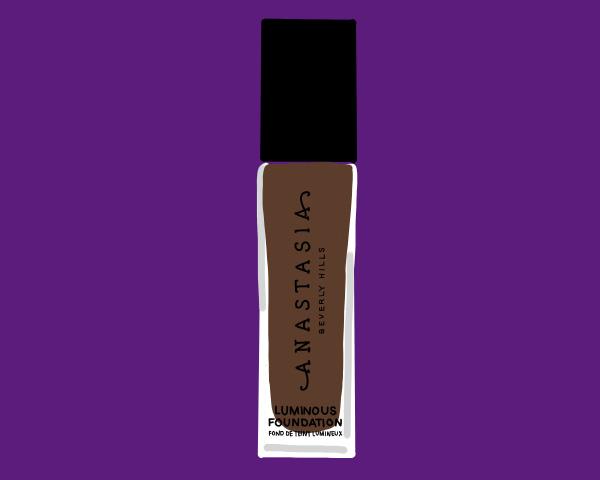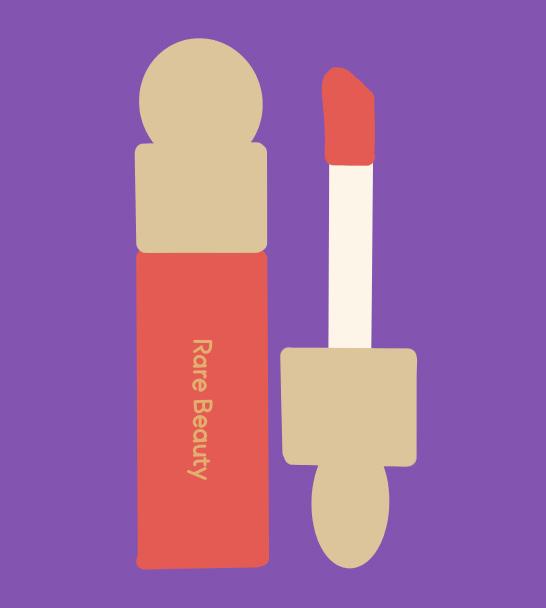
7 minute read
A Brown Girl’s Makeup Routine
By Malvika Iyer
Anastasia Beverly Hills Luminous Foundation: I squeeze out the beige viscous liquid onto a fl uffy brush and start dabbing the product onto my skin. The shades don’t quite match, but it was the best I could fi nd at the beauty store. The color is somewhere between orange and tan, and while it does a decent job of smoothing out my complexion, I can’t pretend that I’m satisfi ed with how my skin looks. I am lucky to have begun wearing foundation when brands are attempting to be more inclusive in their shade range, yet fi nding products for my skin tone always presents itself as a Herculean task where even the professionals in large beauty stores struggle with matching my darker shade. I feel even more disheartened when the advertisements plastered on the large glass windows emphasize the allure of having “milky white” baby skin, soft and smooth, and the products that will help consumers achieve that goal. As I return home with a passable foundation shade, I spread a thick, even layer across my face, and sigh with disappointment as the fl aws and bumps are not quite erased as the advertisements claim, and the darker peach fuzz that covers my cheeks is even more obvious as it is now covered with this coat of paint. But instead of dismissing the foundation as being unsuitable for my skin, I know the failure is in my face, so marred with problems: texture, acne, facial hair…for these are the reasons why my skin doesn’t look like the models plastered on the glass windows of Sephora with their skin being so devoid of imperfections as if they retained the youthful glow of their childhood, a toddler’s supple skin. No. It is my skin, one whose problems not even full-coverage foundation can fi x. The problem is with me, and not with the product, because if models can have “milky white” baby skin, why can’t I?
Advertisement
Nars Creamy Caramel Concealer:
I apply a swipe under my dark circles, acne scars, stubbly chin, and hyperpigmentation. The fi rst makeup product I purchased was concealer, as it was absolutely crucial that I fi x my skin discolouration immediately. I refl ect on the very word, “conceal - er”, which suggests that there are parts of us that must be kept hidden from the outside, parts of us that are undesirable and require elimination. I’ve never thought of myself as getting old, but as I blend the product, I notice it settling into the creases around my eyes. Staring at myself in the mirror, I scrutinize the parts of me that I thought were just normal and now realize that the concealer is hiding signs of aging. The wrinkles on my forehead, fi ne lines around my mouth, hyperpigmentation on my cheeks, and acne scars that occur as we live. We are born with faces that resemble blank slates, and as we live we become marked: our hard work, adversities, and growing pains are all etched into our faces, marking the transition from youthful beginnings to adulthood. Stories are written in faces, in the wrinkles that surround an elderly woman’s eyes indicating she loved life and lived it with joy and smiles, or the dark circles around a student’s eyes, the result of long hours spent in libraries working to pass their exam. If these marks are proof of the living, proof of the trials and tribulations of life, why must I conceal them?

Urban Decay Naked Reloaded Eyeshadow Palette: Some of my earliest moments with makeup involved playing around with bright blue and vibrant purple hues on my eyelids as I dressed up purely for the excitement of getting ready. My 2000s childhood burst with fun colors that led to hours of experimentation. I would sneak out outrageously colored eyeshadows I found in the top drawer of my mother’s vanity, hands shaking with anticipation, as I swiped the intensely colored pigment across my top lid. While streaky, messy, and silly looking, my face would crack into a wide grin as I stared at my now colorful refl ection. After the rush of glee, I would quickly run to the bathroom and wash my face with soap and water, vigorously scrubbing to get rid of any traces of makeup in the fear that my mother would walk in and see my painted face. I feared what she might say, but I’d expect something along the lines of me being too young to be playing with makeup, and that I should be playing outside or doing my homework instead. Experimenting with the bold, scandalous colors of eyeshadow was my expression of creativity and playfulness, yet to my Indian parents, it was a symbol of growing up and maturity. Now, I open my new eyeshadow palette and pick out the colors I want for a more natural, sophisticated look: warm browns, clear beiges, and neutral shades. I prepare myself for a formal interview and while the colors and purpose of eyeshadow may have changed, my attitude has not. To me, eyeshadow is still a way through which I can playfully explore art, color, and beauty. I still recognize that neutral eyeshadow colors and clean looks are important in professional settings, but the possibility of outrageousness that exists with the essentially unlimited creativity of eyeshadow reminds me that there is room for youthful play. My Indian household led me to believe that beginning to wear makeup marks a transition between childhood and womanhood, yet why can’t I give up play?

Himalaya Herbals Black Kohl:
I take a stick of kohl, a cosmetic widely used throughout the Middle East and South Asia, and apply the product to my bottom waterline, adding depth and intensity to my eyes. Kohl is one of my favorite makeup products as it is one of the few my parents let me use it as a child. I would see my aunts and cousins apply it all the time to their eyes and I remember thinking about how stunning it looked. I would admire the beautiful heroines in period Indian dramas who would all sport dramatic eye looks, accentuated by the smoky, seductive look of kohl. When I began wearing kohl as a 13-year-old, it marked the beginning of my teenage years. At that age, everyone around me repeated the same viewpoint: makeup would make me look older and cosmetics were not for children. Yet in South Asia, kohl is even used on babies, an ancient tradition where its application is believed to ward off the evil eye. Unlike eyeshadow, where I playfully experimented, I never felt like a child when I wore kohl; I felt a sense of maturity and beauty that a darkened waterline could bring. Yet living in a small suburban town, I was forced to reconcile the Americanized beauty and makeup standards that I was exposed to at school and in the media with the Indian ones that existed in my household. While most American styles of makeup went unappreciated or scorned in my home, Kohl and eyeliner existed as a bridge between the two. In middle school, while my peers began to wear makeup, I wasn’t allowed to even buy the products they were using. Yet kohl was a middle ground. I felt like I could fi t in and my parents couldn’t pass comments.

Kohl has remained an integral part of my makeup routine, as it is the one product I will not be able to go without: it serves as a symbol of my American graduation from childhood to adulthood, yet simultaneously a way for me to maintain my Indian childhood. Yet while a darkened lower waterline is accepted in my Indian household, mascara-thickened lashes are not. Why must my creativity be limited to a stick of kohl?
Rare Beauty Liquid Blush:
Dabbing a bit of the pink creamy product onto my cheeks, I blend it out with my fi ngers, but grimace at the clownish look that has now ruined the rest of my makeup. Blush has always been a product that I never have had the confi dence to buy and wear but my younger sister’s obsession with the product led me to wonder why I’ve never bothered to try it out. My current refl ection answered my question: blush is not meant for my skin. Blush has always been associated with youthfulness and beauty standards have solidifi ed the notion that sporting rosy cheeks is considered very attractive. This was always against the backdrop of pale skin, a standard that I could never reach. Far from looking natural, blush has never matched my skin tone. It has looked more like stage makeup than the natural, glowy, youthful look I’ve seen on paler skin around me. My Instagram feed is fi lled with makeup tutorials that all aim to create a dewey, doll-like look, and blush is the most important product in those routines. But every content creator I see has pale skin, and perfectly sculpted cheekbones, features that I so painfully lack. While I might struggle with artistic creativity using eyeshadow, or fruitlessly attempt to fi nd my foundation shade, I know that I at least have options with those products: but blush is a product I can never use. I use a Q-tip and micellar water to remove the blush from my cheeks, angry that the product has set an unattainable standard. Why must I look like a child to be considered more attractive?
Fenty Cream Lip Gloss - Cookie Jar:

As I swipe the gloss across my lips, I feel a sense of satisfaction. Lip products are where I never feel out of my depth. My full lips (from my father) have seen more shades than a rainbow as I’ve played with soft pinks, bold reds, vibrant oranges, and natural browns. The lack of shade variety is so painfully obvious in foundation and blush, but I run no shortage of lip products. While I struggle with balancing products that make me feel older like concealer, and those like eyeshadow that bring out my childlike playfulness, I know I can do anything with my lips. Pinks for cuter looks, red for when I want to make a statement, brown for embracing my two-toned lips. The wariness that I feel with other makeup products all but disappears as soon as I open a tube of lip gloss. Insecurities are erased, and worries about age cease to exist and instead are replaced with a newfound sense of confi dence and a smile. As I get older, I fi nd myself becoming more and more comfortable with using makeup as a means of expression, instead of worrying about what my parents will say or what other people will think about me, and as dramatic as it may sound, I owe it to lipstick.









